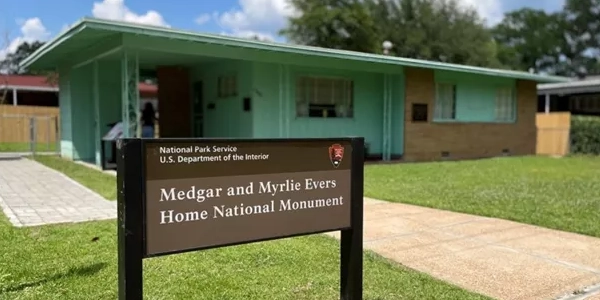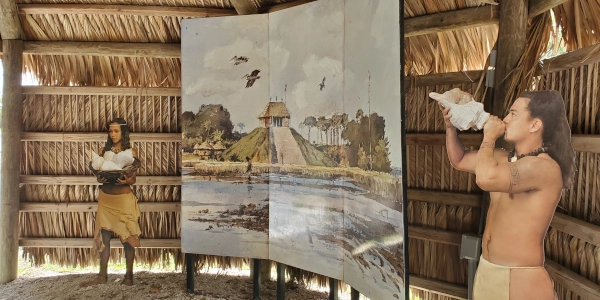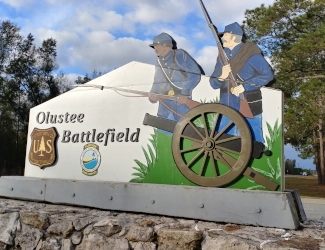
Image above: Olustee Battlefield Historic Park sign at entrance to the park. Courtesy America's Best History.
Spotlight on Lesser Known History
Olustee Battlefield
Florida
America's Best History Spotlight
On this page we're going to Spotlight the lesser known historic sites and attractions that dot the history landscape across the USA and are worth a visit if you're in their area. And while they may be lesser known, some are very unique, and will be that rare find. You'll be, at times, on the ground floor, or maybe even know something others don't. It'll be fun. Visit them.
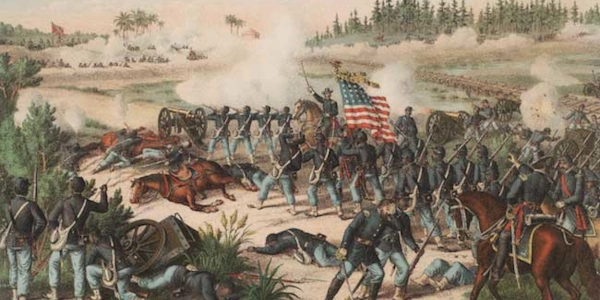
Battle of Olustee, Florida
Not far from the Jacksonville national parks of Timucuan National Park and Preserve and Fort Caroline is the Olustee Battlefield, which was the main attempt to create a Sherman to the sea moment for Union General Truman Seymour to make their mark to control Florida in February 1864. It failed. The Confederates, after a tough battle within the tall piles and underpalms (less then than now due to farming and ranching), they would force the Union Army back to Jacksonville, never really putting Florida in jeopardy again. It was about five thousand soldiers on both sides; and some of the best fighting for the Union, even during their retreat, was by the three colored regiments that participated. Olustee Battlefield and Historic Park is the oldest state park in the state of Florida.
Photo above: Lithograph of the Battle of Olustee on February 20, 1864, 1864, Kurz and Allison. Courtesy Wikipedia Commons via the Florida Memory Project.
Sponsor this page for $100 per year. Your banner or text ad can fill the space above.
Click here to Sponsor the page and how to reserve your ad.
Info, What's There Now, History Nearby
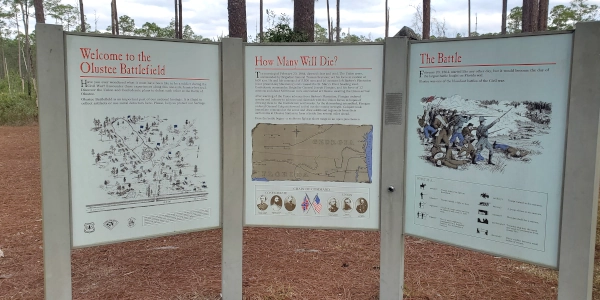
Battle of Olustee, Florida
The battles of 1864 in the north had not yet raged between Union General Grant and Confederate General Lee at Wilderness and Spotsylvania, but there were plans afoot to cut off the food supplies from Florida that had been helping keep the Confederate army afloat. After this had been accomplished, General Seymour went west toward Tallahassee, thinking only Confederate militia would be in his way. He was wrong. A battle, near Olustee, or Ocean Pond, was not going to be the Union victory to take over Florida for good. Union Brigadier General Truman Seymour with five thousand five hundred men, including the 35th U.S. Colored Troops, the 8th U.S. Colored Troops, and the 54th Massachusetts, would be met by five thousand soldiers under Confederate Brigadier General Joseph Finegan and Brigadier General Alfred Colquitt. Although a quick push was gained by the Union forces, the fighting became fierce over five hours beneath the pines, eventually causing the Union to become overwhelmed with Seymour ordering a withdrawal back to Jacksonville. Casualties (killed, wounded, and missing) were 1,861 Union; 946 Confederate.
Image above: Photo of the Olustee Battlefield sign at the beginning of the one mile walking tour. Courtesy America's Best History. Below: Wood engraving of the Battle of Olustee, 1866, Harper's New Monthly Magazine, v33. Courtesy Library of Congress.
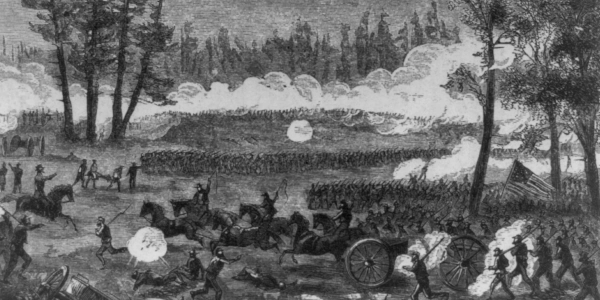
Where Is It
The Olustee Battlefield Park is located just off of Interstate 10 west of Jacksonville, about a forty-five minute drive. There is good camping nearby in the Osceola National Forest, which still, as of 2024, allowed primitive pull in without a reservation camping. The Olustee park is located at 5815 Battlefield Trail Road, Olustee, Florida 32087.
Minute Walk in History
Take a walk around the Olustee Battlefield with us as we cross the grounds of the largest Civil War battle held in the state of Florida and subsequently made into Florida's first state park. A one mile trail, small visitor center, and several monuments to the Confederates who won are included. The narration in from the official report of Union General Truman Seymour and his words reflect the battle and loss from the Federal perspective. The Confederate perspective can be seen toward the end of the video when the after war park pays history to its victory and commanders, General Joseph Finegan and General Alfred Colquitt. Narration by Jason Donovan. Photos by America's Best History, Library of Congress, and Wikipedia Commons.
What is There Now
Olustee Battlefield
The Olustee Battlefield History Park, as the first state park in Florida, tells the historic story of the Battle of Olustee in 1864. There is a small visitor center with exhibits, to be replaced with a larger and newer building in the near future. There is a one mile walking trail through the pine forest with many waysides telling you what happened where during the five hours of battle. There are picnic tables. And if you are in the area around the weekend near February 20, there is an annual reenactment.
When Open and How Much
No fee. The site is open daily 9 a.m. to 5 p.m. There are a few parking spaces in front of the visitor center and more parking on the grass near the picnic tables.
Fees and hours are subject to change.
Websites
Olustee Battlefield Historic Park
Olustee Battlefield Park and Reenactment
History Nearby
There's so much to see in the northern part of Florida that should get just as much attention as those big parks in the south. Although the Olustee Battlefield Historic Park is a state park, there are more than a few national parks just a couple hours, or even less, away. In St. Augustine itself, there are the Castillo de San Marcos National Monument and Fort Matanzas National Monument, both which protected, one better than the other, when the British and pirates attacked.
-
Timucuan NP
and Preserve -
St. Augustine
-
St. Augustine's Forts
-
Canaveral
National Seashore -
Gulf Islands
National Seashore
Photos, History, and More Spotlights
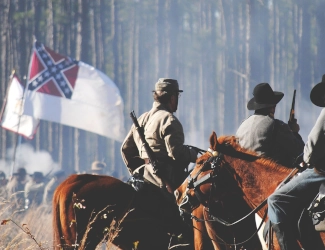
Description from Official Records
Olustee (Ocean Pond), Brig. Gen. Truman Seymour, USA vs. Brig. Gen. Joseph Finegan, CSA.
The two sides had around 5,000 men each with the Union casualties being around 1,900 and Confederate just under 1,000. In February 1864, the commander of the Department of the South, Maj. Gen. Quincy Gillmore, dispatched an expedition to Florida to expand Union enclaves, sever Rebel supply routes, and recruit black soldiers. However, his main objective, if an underlying one, was to secure Florida's electoral votes for Lincoln in the coming election. Gillmore expected little opposition, and thought a Unionist government could easily be organized in East Florida, or even that anti-Confederate sentiment would allow easy occupation of the populated part of the state.
Seymour was sent with about 5,000 men, a mix of veteran and green units that had been involved in the siege of Charleston. The troops occupied Jacksonville without opposition and moved quickly inland against negligible resistance. Afterwards, they paused to consolidate their gains and for the political agents to administer oaths of loyalty, but the delay allowed the Confederates to gather reinforcements of two veteran brigades. On February 20th, Seymour moved west in three columns, with the cavalry covering the advance; his route was along the railroad line to Lake City. Finegan had begun entrenchments, but the arrival of reinforcements had changed the odds, and he was more aggressive. The cavalry pickets quickly made contact with the advancing Union troops, and made sure Finegan knew the situation. As the Yankees approached the main line the cavalry fought harder, and Finegan sent infantry to support them rather than ordering a withdrawal to the entrenchments.
The two sides both fed reinforcements to the skirmish; Seymour fed in Hawley's Brigade as Finegan let Colquitt handle the engagement, which soon drew in his entire brigade. Hawley's men soon collapsed; the 7th New Hampshire deployed badly and were quickly routed in confusion. The 8th USCT, a very green unit, fought for a time but with the death of their colonel soon lost cohesion. Finegan reinforced success, and Harrison's Brigade came up to help Colquitt turn tactical success into victory. Seymour knew he had to stave off defeat, and advanced the experienced New Yorkers of Barton's Brigade. The two forces slugged it out; while the Confederates had a temporary numerical advantage they were also low on ammunition and several regiments could only stand still waiting for fresh supplies. Finegan arrived himself with the last reserves and the ammunition, and the combination tipped the balance. In the end, Barton's men, worn down, could not hold and Seymour had to commit his last brigade as a rearguard.
Photo above: Photo of the annual Battle of Olustee reenactment, 2014, Excel23. Courtesy Wikipedia Commons, C.C. 3.0.
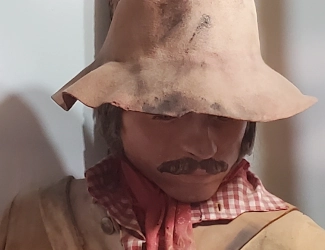
Official Records Account, Continued. While fighting hard and losing heavily, the African-Americans of the 35th USCT and 54th Massachusetts checked the Confederate advance until daylight faded. Seymour was evacuating his most battered units back to Barbers' plantation under protection of the two regiments and his cavalry. In earnest, much had to be left behind and prisoners, both wounded and unwounded, numbered almost a thousand. The Confederate soldiers also captured supplies and several artillery pieces. The cost to the Union was about 40% of the troops in action, while the Confederates had lost around 20% in their victory. Overall, it could be one of the bloodiest battles in Florida, and in percentages one of the bloodier battles of the war.
Ultimately, Finegan did not follow up his victory, and most of the fleeing Union troops reached Jacksonville by the 22nd - only two days.
Image above: Photo of an exhibit of a Confederate soldier in the Visitor Center. Below: Diorama of the Battle of Olustee in the Visitor Center. Both photos courtesy America's Best History.
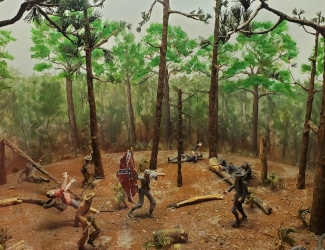
Buy Second Edition
America's Best History Timeline

Great book to keep middle school to college students up to date on their American history.
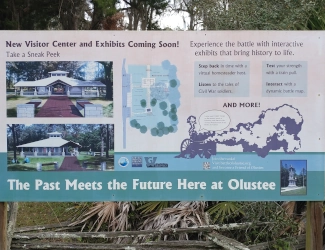
Visitor Center Plans and Monuments
There are plans in the works to construct a larger visitor center to accommodate the crowds of visitors that come every February for the reenactment of the largest Civil War battle held in the state of Florida. There are only a few monuments on the field. One which honors the Confederate soldiers behind the current visitor center. And two, surrounded by cannon, that tell the story of the battle and one honoring Confederate General and future Governor Alfred Colquitt, known as the hero of Olustee, as well as one for his commanding officer, General Joseph Finegan.
Photo above: Sign of plans for the new Olustee Visitor Center. Below: One of two small monuments on the Olustee Battlefield. Both courtesy America's Best History
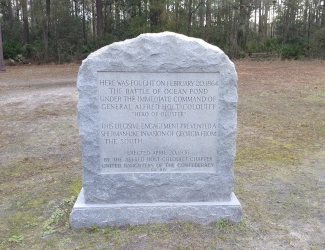

T-Shirts and Gifts from the official souvenirs of Americasbesthistory.com.
About
America's Best History where we take a look at the timeline of American History and the historic sites and national parks that hold that history within their lands.
Photos courtesy of the Library of Congress, National Archives, National Park Service, americasbesthistory.com and its licensors.
- Contact Us
- About
- © 2024 Americasbesthistory.com.
Template by w3layouts.
